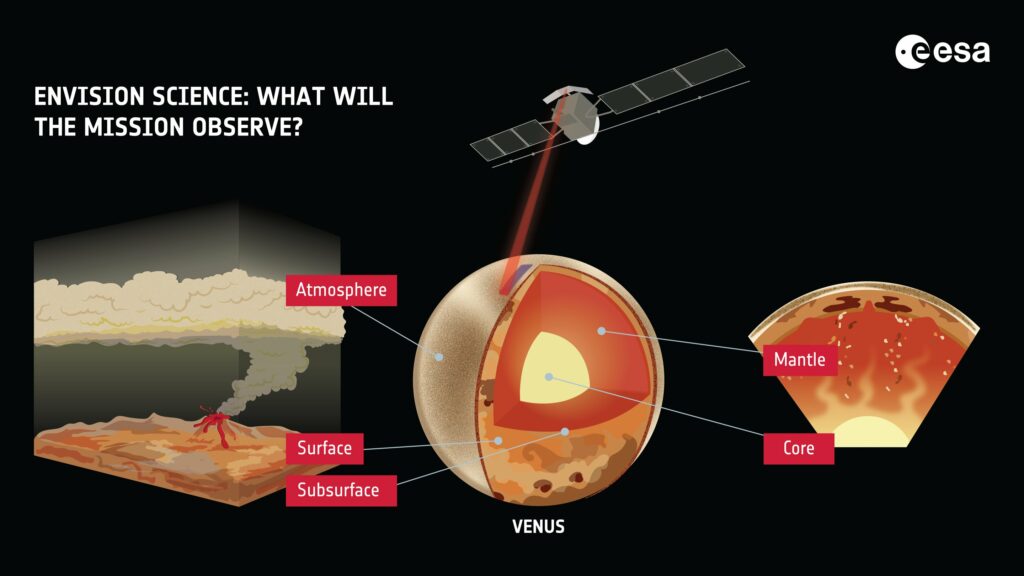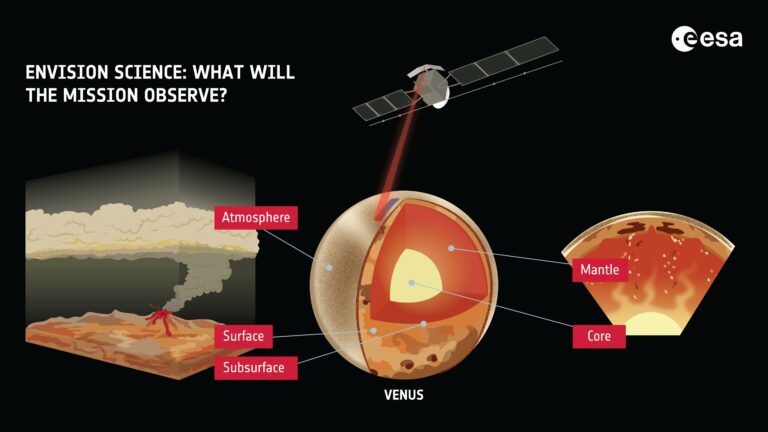EnVision Mission Approved by ESA for Venus Exploration
ESA’s next mission to Venus was officially “adopted” today by the Agency’s Science Program Committee. EnVision will study Venus from its inner core to its outer atmosphere, giving important new insight into the planet’s history, geological activity and climate.
Being adopted means that the study phase is complete and ESA commits to implementing the mission. Following selection of the European industrial contractor later this year, work will soon begin to finalize the design and build the spacecraft. EnVision is foreseen to launch on an Ariane 6 rocket in 2031.
“Since the mission was selected back in 2021, we have advanced from broad science goals to a concrete mission plan,” says ESA EnVision study manager Thomas Voirin. “We’re very excited about moving to the next step. EnVision will answer longstanding open questions about Venus, arguably the least understood of the solar system’s terrestrial planets.”
Venus is Earth’s closest neighbor—much closer than Mars—and very similar to our home planet in mass and size. Unlike Earth, however, it is not a pleasant place to visit. Of the solar system’s rocky bodies, it has the densest atmosphere, and it is completely covered by layers of thick clouds made mostly of sulfuric acid. The surface of Venus is a scorching 464°C on average, with a crushing air pressure 92 times bigger than we experience on Earth’s surface. This leaves us to wonder: How and when did Earth’s twin become so inhospitable?

Science with EnVision
The measurements EnVision makes will help unravel key mysteries of our hot neighbor. For example, EnVision will reveal how volcanoes, plate tectonics and asteroid impacts have shaped the Venusian surface, and how geologically active the planet is today. The mission will also investigate the planet’s insides, collecting data on the structure and thickness of Venus’s core, mantle and crust. Last, it will study the weather and climate on Venus, including how they are affected by geological activity on the ground.
“Special to EnVision is the mission’s approach to studying the entire planet as a system. It will investigate Venus’s surface, interior and atmosphere with unprecedented accuracy, allowing us to understand how they work and interact with each other. For example, EnVision will use multiple measurement techniques to search for signatures of active volcanism at the surface and in the atmosphere,” explains Anne Grete Straume-Lindner, the mission’s project scientist.
To enable this holistic investigation, EnVision will carry an extensive set of scientific instruments. It will be the first mission to directly probe beneath Venus’s surface, using its subsurface radar sounder. A second radar instrument, VenSAR, will map the surface with a resolution down to 10 meters and determine properties such as surface texture. Three different spectrometers will study the make-up of the surface and atmosphere. And a radio science experiment will use radio waves to study the planet’s internal structure and properties of the atmosphere.
Strong heritage and fruitful cooperation
EnVision will join ESA’s science fleet of solar system explorers. These missions address two top-level science themes of ESA’s Cosmic Vision 2015–2025, namely: What are the conditions for planet formation and the emergence of life? and How does the solar system work?
It will be the second European mission to Venus. ESA’s Venus Express (2005–2014) focused on the planet’s atmosphere, but also made dramatic discoveries that pointed to possible volcanic hotspots on the planet’s surface. The study of the atmosphere has continued with JAXA’s Akatsuki mission, which is still actively tracking atmospheric movement and Venusian weather.
Longer ago, NASA’s Mariner and Pioneer Venus missions (1960s and 1970s), the Soviet Union’s Venera and Vega missions (1960s to 1980s), and NASA’s Magellan radar mapping mission (1990–1994) painted a picture of a dry world, with landscapes shaped by volcanoes and intense geological activity. They discovered vast plains marked by lava flows, bordered by highlands and mountains. EnVision’s VenSAR instrument, expected to be contributed by NASA, will map the Venusian surface at a much higher resolution than Magellan, distinguishing surface features more than ten times smaller.
This time around, EnVision will not be alone on its trip to Venus. Expecting a fruitful collaboration, NASA has also selected two new missions to Venus as part of its Discovery Program: DAVINCI (Deep Atmosphere Venus Investigation of Noble gases, Chemistry, and Imaging) and VERITAS (Venus Emissivity, Radio Science, InSAR, Topography, and Spectroscopy). Together, EnVision, DAVINCI and VERITAS will provide the most comprehensive study of Venus ever.
This article is republished from PhysORG under a Creative Commons license. Read the original article.
Do not forget to share your opinion with us to provide you with the best posts !




0 Comments